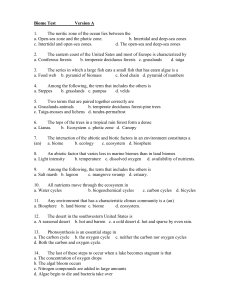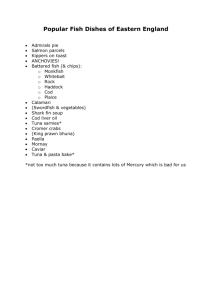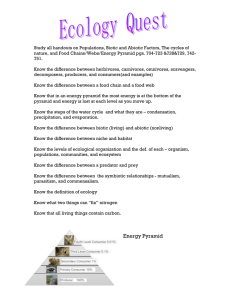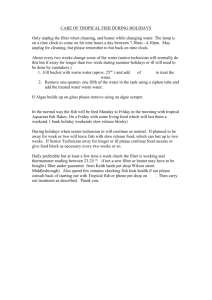Biome Test Version A
advertisement
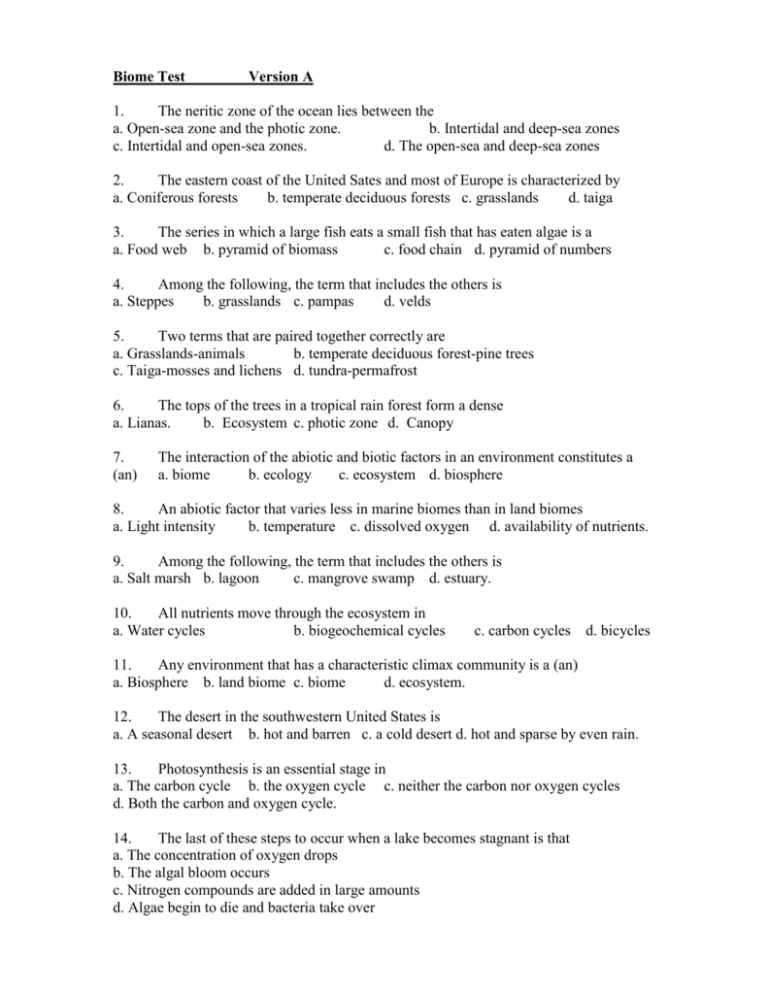
Biome Test Version A 1. The neritic zone of the ocean lies between the a. Open-sea zone and the photic zone. b. Intertidal and deep-sea zones c. Intertidal and open-sea zones. d. The open-sea and deep-sea zones 2. The eastern coast of the United Sates and most of Europe is characterized by a. Coniferous forests b. temperate deciduous forests c. grasslands d. taiga 3. The series in which a large fish eats a small fish that has eaten algae is a a. Food web b. pyramid of biomass c. food chain d. pyramid of numbers 4. Among the following, the term that includes the others is a. Steppes b. grasslands c. pampas d. velds 5. Two terms that are paired together correctly are a. Grasslands-animals b. temperate deciduous forest-pine trees c. Taiga-mosses and lichens d. tundra-permafrost 6. The tops of the trees in a tropical rain forest form a dense a. Lianas. b. Ecosystem c. photic zone d. Canopy 7. (an) The interaction of the abiotic and biotic factors in an environment constitutes a a. biome b. ecology c. ecosystem d. biosphere 8. An abiotic factor that varies less in marine biomes than in land biomes a. Light intensity b. temperature c. dissolved oxygen d. availability of nutrients. 9. Among the following, the term that includes the others is a. Salt marsh b. lagoon c. mangrove swamp d. estuary. 10. All nutrients move through the ecosystem in a. Water cycles b. biogeochemical cycles c. carbon cycles d. bicycles 11. Any environment that has a characteristic climax community is a (an) a. Biosphere b. land biome c. biome d. ecosystem. 12. The desert in the southwestern United States is a. A seasonal desert b. hot and barren c. a cold desert d. hot and sparse by even rain. 13. Photosynthesis is an essential stage in a. The carbon cycle b. the oxygen cycle c. neither the carbon nor oxygen cycles d. Both the carbon and oxygen cycle. 14. The last of these steps to occur when a lake becomes stagnant is that a. The concentration of oxygen drops b. The algal bloom occurs c. Nitrogen compounds are added in large amounts d. Algae begin to die and bacteria take over 15. A climax community is determined by the a. Temperature and rainfall b. major forms of animal life c. Major forms of plant life d. latitude and climate 16. In the water cycle, precipitation must be immediately a. Followed by further precipitation b. preceded by condensation c. Followed by condensation d. preceded by evaporation 17. Marine biomes are divided into ecologically distinct zones depending on a. Depth and distance from shore b. temperature and distance from shore c. Plant life present d. type of fish present. 18. On an abandoned farm in New England, succession usually begins with the growth of ecological a. grasses b. small shrubs c. poplar trees d. weeds 19. In the nitrogen cycle, bacteria that live on the roots of legumes a. break down nitrogen compounds into free nitrogen b. change free nitrogen in nitrogen compounds c. change free nitrogen into plant proteins d. denitrify nitrogen compounds 20. In a marine biome, organisms experience radical changes in their environment each day in the a. deep-sea zone b. open-sea zone c. neritic zone d. intertidal zone 21. All of the sun’s energy that reaches the Earth, the amount used by living things is approximately a. 10% b. 5% c. 1% d. 0.1% 22. The total mass of living tissue at each trophic level can be shown in a a. pyramid of energy b. cycle of matter c. pyramid of biomass d. pyramid of numbers. 23. a. c. In a series of trophic levels, the animals farthest from the producer usually have the most biomass b. receive the most energy are the largest in number d. receive the least energy 24. Unlike matter, energy a. can be recycled b. can be transferred c. cannot be recycled d. cannot be transferred e. is stupid. 316. A student found a particular pond community to consist primarily of turtle, bass, snail, algae, and fungi populations. The producer in this community would be the ____. A. turtle B. fungi C. snail D. algae E. bass 317. In a typical ecosystem, everything cycles with the exception of ____. A. oxygen B. nitrogen C. water D. energy E. carbon 318. A food chain for a prairie could be as follows: grass, rabbit, snake, hawk. The snake represents which of the following? A. autotroph B. secondary consumer or second trophic level C. tertiary consumer or third trophic level D. herbivore E. primary consumer or first trophic level 319. In a lake containing sunfish, northern pike, water bugs, algae, and minnows, the organism that would be present in the smallest numbers would be ____. A. sunfish B. algae C. northern pike D. water bugs E. minnows 321. In the North Sea, tuna feed on herring and herring feed on sand eels. Cod and seabirds also feed on the eels. Assuming that North Sea fishermen overfish cod and herring to the point that their populations greatly decrease, what is the most likely result on the tuna and seabird populations? A. Tuna and seabird populations will both increase B. Tuna population will increase while seabirds will decrease C. Tuna population will decrease while seabirds will increase D. Tuna and seabird populations will both decrease E. Tuna and seabird populations will stay more or less the same 322. Homo sapiens has probably had a greater effect on the biosphere than any other organism because of ____. A. an internal skeleton B. upright posture and forward facing eyes C. homeostasis D. the ability to modify the environment E. efficient respiration 327. The pesticide DDT was used to control mosquito larvae in a 100 acre lake. One year after the application, fish species A had a DDT concentration of 0.01 mg/gm,while fish species B had 0.1 mg/g. These differences suggest that ____. A. fish A eats fish B B. fish B eats fish A C. both fish species are herbivores D. both fish species are carnivores E. both fish species are omnivores A=Predator B=Commensalism C=Mutualism D=Parasitism E=Communism 1. 2. 3. Both benefit One benefits, one is harmed One benefits, one is unaffected
